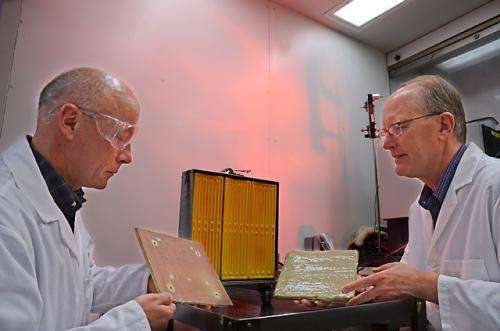Temporary coating may help protect homes from wildfires

When a forest or brushland wildfire threatens to engulf nearby neighborhoods, some homeowners might opt to quickly spray the entire exterior of their house with a temporary fire-retardant coating. Now, a team of Agricultural Research Service scientists in California—one of America's most wildfire-prone states—has shown that an experimental fire-retardant gel made of sodium bentonite clay, cornstarch, and water may offer better, more affordable protection than gels made from other compounds.
Preliminary research, led by plant physiologist Greg Glenn at the agency's Western Regional Research Center in Albany, provides a foundation for more extensive tests of the promising, all-natural coating.
According to Glenn, results suggest that a layer of gel—about one-quarter-inch thick—"may protect wood-based home siding for up to 30 minutes."
Depending on the circumstances, that might be long enough to save a home. "In a best-case scenario," he says, "all you might have to do is wash the coating off your house after the fire."
For the research, Glenn and coinvestigators cut planks of residential wood-based siding into 7-inch squares, about 3/8-inch thick, then coated all but the "control" squares with the experimental gel, a commercial gel, or other formulations.
The experimental clay-and-starch gel outperformed the other coatings in several experiments.
For example, "drying tests" showed that the gel kept its moisture longer—a quality important for a fire retardant. In those tests, the coated siding was kept for 6 hours in an oven set at 111°F, to simulate the moisture-robbing effects of the high temperatures and hot, drying winds typical of "high-fire-danger" weather in some parts of the country. The 6-hour timeframe was chosen as one example of how many hours in advance of a wildfire a protective coating might be applied.
In "burn tests," siding coated with the clay-and-starch gel took longer to reach 392°F, the temperature at which wood-based siding may begin to burn and char. In these experiments, the coated siding was exposed to 960°F heat—a temperature not uncommon for a brushfire, for example—until the siding reached the 392°F burning point.
Other tests, in which the squares were positioned upright, showed that the gel was less prone to sliding, technically known as "slumping," toward the bottom of the squares. The starch, Glenn says, helped the coating to stay in place and, in so doing, shield the siding.
Sodium bentonite clay and starch are not new to firefighting, but the California team's idea of combining these materials to form a fire-retardant coating is apparently a first, as is the team's detailed analysis of the coating's effectiveness. ARS is seeking a patent for the research.
Chemist Bor-Sen Chiou, food technologist Artur Klamczynski, and agricultural engineer Zhongli Pan, all at Albany, and former Albany researcher Gokhan Bingol collaborated with Glenn in the study. They documented their findings in a peer-reviewed article published in 2012 in Fire Safety Journal.
"Experimental Wildfire-Retardant Coating May Help Protect Homes" was published in the September 2013 issue of Agricultural Research magazine.
More information: www.ars.usda.gov/is/AR/archive/sep13/
Journal information: Agricultural Research
Provided by Agricultural Research Service



















